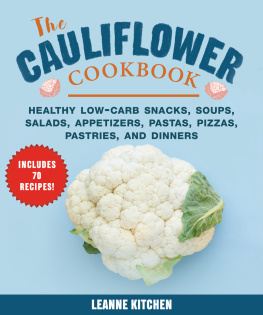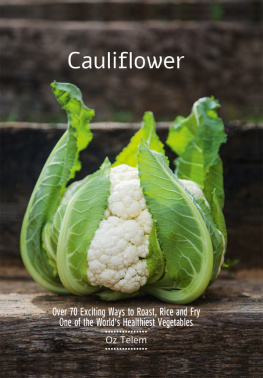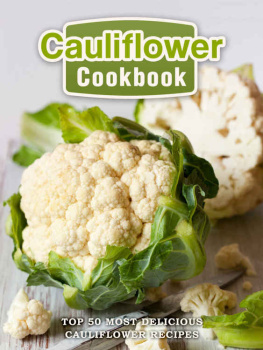


CONTENTS
INTR ODUCTION T O CAULIFLOWER
Big and boofy, theres nothing quite like a cauliflower. And it seems the world is realizing exactly thatits fair to say that this king of vegetables is having something of a zeitgeist moment right now. As a variety of Brassica oleracea, cauliflower is closely related to broccoli (another vegetable unusual for the fact that we eat the flower) and is reckoned to have evolved from wild cabbage. Its characteristic appearance is actually the result of arrested developmentthe normal forming of flower and stalk is interrupted, causing the immature flower heads to accumulate in a large mass. In this, the cauli is somewhat unique, although it does have plenty of other brassica family members: broccoli, cabbage, kale, kohlrabi, Brussels sprouts and Chinese broccolieven turnips, wasabi, arugula and horseradishare all related to it. But in terms of looks, flavor and downright versatility, the cauliflower is pretty much out there on its own. With so many ways to prepare it, cauliflower has long been a kitchen stalwart.
FROM WHENCE THE CAULIFLOWER?
Before we get into the practicalities of cauli cooking and all the great things you can do with your favorite brassica, first a little background info. The name cauliflower literally means cabbage flower from the Latin caulis or cabbage and flower for, well, flower. Its thought that cauliflowers initially popped up in Cyprus (although some reckon Egypt). Roman-era writer Pliny the Elder enthused about cauli in his first-century opus Natural History, wherein he pronounced it the most pleasant-tasted (sic) of all the cabbages (although its likely he was describing an earlier form of the cauliflower, not the one we know and love today).
The Cyprus connection makes sense when one considers that the island went on to become an English colony; theres a theory that cauliflower made it to England in the seventeenth century from here, although some say it was introduced to Britain by Flemish weavers. Three varieties of cauliflower were written about in Spain in the twelfth century, although our modern version was first used in Italy when, around 1500, it blew into Genoa from either Cyprus or the Levant. From there it traveled to France sometime later in the sixteenth century, where it became wildly popular in the court of Louis XIV. It was considered a delicacy, and the French aristocracy slathered it in ridiculously rich sauces, packed with palace favorites such as cream, foie gras, sweetbreads, ham and mushrooms.
An interesting relic from French culinary history is that the words du Barry denote cauliflower dishes in the classical cooking repertoire. This is after Madame du Barry, a French courtesan during the reign of Louis XV. Its not agreed how she came to be so closely connected with cauliflower, but crme du Barry, for example, is still a posh way of saying cauliflower soup. Hypotheses for the association include that her white powdered hair-do resembled cauliflower curds, and that her pale complexion was cauliflower-like in color. Madame du Barry met her fate at the blade of the guillotine during the French Revolution. Let them eat brassica?
From Europe to the rest of the world? Interestingly, cauliflower didnt become commercially available in America until the 1920s. One cuisine that does have a prodigious number of cauliflower recipes is India (the Brits introduced it there) and now India is second only to China as the largest grower of the vegetable king.
KING OF CURDS
The edible part of cauliflower is composed of tightly clustered florets that are usually, but not always, whitemore on that later. These are called the curd. Enclosed by tight green leaves, the curd is considered the business end of the cauli, though you can happily eat the stalk and the long, pale green leaves that hug it. Mostly though, the leaves are hacked off before you buy, which is a shame. As well as tasting great, theyre a good indicator of freshnessthey should be pert and tight, not floppy. When the cauliflower is in the ground, the leaves draw up to cover the curd, protecting it from sunlight and preventing it from producing chlorophyll and turning green. Hence... whiteness.
Cauliflowers are notoriously tricky to grow, which might explain why theyre never bargain-basement cheap. An autumn/winter crop (although you can buy them year round thanks to modern agriculture), theyre sensitive to extreme cold, as well as extreme heat, and dont like sudden changes in temperature or rainfall. Theyre also picky about their soil, although new hybrids are less sensitive.
So, lets assume that, unless youre an ace gardener, youre buying your cauliflowers. When you do, choose those that feel heavy and compact and have an unblemished, creamy and tight curd. The curd should not be blindingly bright white, as this signifies the vegetable is not yet fully mature. Any loose or discolored curds tell you the cauli is past its best. Buy whole cauliflowers rather than pre-cut, if you can avoid them. An uncut cauli will keep longerup to seven days in an open plastic bag in the crisper section of the fridgewhereas cut florets will only be good for a few days. Store a whole cauliflower stem down, as storing it head down can result in moisture accumulation, which causes it to spoil. Washing a cauliflower before you store it can also cause spoilage, so dont do that, either.

THE ANATOMY OF A CAULIFLOWER
VARIATIONS ON A THEME
As for varieties, there are a few. A restaurant-driven trend for baby vegetables has given rise to cute tiny caulis recently; around the size of large tennis balls. These arent mainstream though, so youll be lucky to see them outside specialty produce stores.
Then there are purple cauliflowers, which get their color (the curds vary from light to dark mauve) from the presence of anthocyanin, the same pigment that is in red wine and red cabbage. A powerful antioxidant, anthocyanin is thought to deliver potent health benefits. Purple cauliflower contains more vitamin A than white cauli.

The green cauliflower is also called Broccoflower, a trademarked name for a cross between broccoli and cauliflower. It looks just like a regular cauliflower, but with curds of pretty lime green. The romanesco cauliflower is also green but, instead of smooth curds, the florets are shaped into beautiful pointy lumps that range out in a swirly pattern from the central core. Its renowned in the scientific community for this fractal patterning, wherein the lovely pointy bits look exactly the same at every scale (some are big, some are small) and there are mathematical laws behind its incredible symmetry. Romanesco cauliflowers, first cultivated near Rome in the sixteenth century, are related to both cauliflower and broccoli. Creamy and nutty flavored, they dont have any of that slightly bitter edge those other two vegetables can sometimes have and, culinarily speaking, whatever you can do with a cauliflower, you can do with the romanesco version.
Next page


















